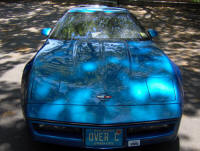RIKLBLOG
|
| Tomorrow |
| 28 June 2008 |
| Yesterday |
| Index |
| Eventide |
| SETI League |
| PriUPS Project |
| Bonus! |
| Contact |


Your Plug-In Prius
In my blog "yesterday" I ended with this comment:
But I will elaborate on the reason I suddenly became interested in the data. Look for that in tomorrow's blog, or perhaps a few blogs hence if I decide to disclose my latest invention, the Magnetowel(TM) first.
Although I am eager to get to the Magnetowel, I did want to belatedly finish discussing the issue of my battery voltage. First, a bit of background.
The Plug-In Hybrid
You can hardly read a newspaper story about automobiles any more without seeing a mention of the Prius or the hypothetical Chevy Volt. The latter will be born as a plug-in hybrid, the first is rumored to be available as a plug-in with the 2010 model year. The plug-in hybrid is the rage because it uses less gasoline. Instead of having a modest battery that can store perhaps a kilowatt hour of energy and that recycles energy otherwise wasted by braking, a plug-in has a battery that can store 5kWH or more of energy. This is enough to power the car for a number of miles—perhaps for a full commute—without using any gasoline. Since the battery can be recharged from an electric outlet, it is possible to get upwards of 100mpg from a plug-in hybrid or, under some circumstances, use no gasoline at all!
I don't have one of these, although I plan to get one as soon as they're commercially available. It is possible to get one now by paying a fortune for a big battery and modifying the Prius, but the economics are daunting. See, for example, my review of the Edrive product.
But, while I was thinking about the subject of the plug-in, I had a sudden realization: My Prius (and yours, if you're one of the rapidly increasing number of owners) is already a plug-in hybrid, at least in theory! To be sure, it's not much of one due to battery limitations, but even so, the possibility is there.
Hypermiling
There is a subgroup of car owners who consider themselves "hypermilers." Their goal—really their obsession—is to get as many miles per gallon from their car, often a Prius, as is physically possible. They use a number of techniques such as driving slowly, something called "pulse and glide" and other practices that are potentially unsafe while they are driving in traffic. They make what seem to me astonishing claims that they get 60 to 100mpg from a Prius. (My lifetime average is about 50mpg, and I'm very careful albeit not obsessed.) Regardless of whether the claims are entirely true, what is definitely true is that there are techniques that can improve one's mileage. For example, I use a GPS to time traffic lights, often eliminating the stopping caused by that scourge from my daily commute. Another technique that I don't use, and I'm not aware that anyone does, is to charge the standard Prius battery from an electric outlet (or other source of power).
The Standard Plug-In Prius
The Prius is heavily computerized. One of the important goals of the computer is to monitor the state of charge (SOC) of the built-in NiMH battery. The computer tries to keep it at some intermediate level between a 40% and 80% charge, the levels at which the battery has the longest lifetime. In normal driving it succeeds very well. When a boost of power is needed or you're draining the battery while stuck in traffic, the SOC can go to the lower end of the desired level, at which time the internal combustion engine will start up and charge the battery, even if the car doesn't need to move. (This function is the basis of the PriUPS project.) Contrarily, if you're coasting down a big hill, some of the potential energy being dissipated is directed to the battery, which will now exceed the intermediate level. If the hill is long enough, the battery will reach a full 80% SOC, following which the computer will direct the engine to use more battery and less gas power as soon as it is able. And that is the basis for this plug-in idea.
Let's say you don't live or work at the bottom or the top of a big hill. If you drive a Prius, that means that when you arrive at your destination, your battery will most likely be at an intermediate state of charge. If you were to top it off by adding, say, 250 Watthours of energy, or whatever is necessary to bring it to the "full" 80% SOC, that would be energy that the gas engine doesn't have to provide. Is 250WH significant? That's enough energy to go perhaps a half mile or so. (There are no calculations behind these numbers, by the way. Although I went to the trouble of monitoring my voltage in the previous blog, the info didn't turn out to be of much use.) If your commute is 10 miles in each direction, and you can charge the battery at both ends, you will increase your gas mileage by about 5 per cent at the cost of a few pennies worth of electricity. Good, but a bit of a nuisance. Worth it? To a hypermiler, perhaps. To me, not really, and so I have no test data to prove it. (If gas gets any more expensive, I might change my tune!)
If I, a three-pen nerd and gadget lover isn't going to bother with this, why would anyone else?
Making It Worthwhile
For one thing, I have used a typical and somewhat conservative case as an example. Let's say your commute is five miles. And that you're not quite as careful as Toyota to keep the charge no higher than 80%. If you can add enough charge to the battery to go a full extra mile, suddenly you've improved your mileage by 20%! (If your average trip is only five miles, though, you're not getting great mileage from your Prius for other reasons.)
Furthermore, and sadly this is unlikely to happen, Toyota could cooperate by linking the GPS to the engine computer. Simply by recognizing when the car is near a driver-specified end point, it could instruct the battery to provide more power so that it is near the bottom of the allowed SOC when the destination is reached. That, of course, would permit a greater charge to be added by the electric grid. In Europe, the standard Prius has an electric-only mode switch. My understanding is that by using that mode, the car will preferentially use battery power until the minimum SOC is reached. Perhaps someone with this feature (or who added the modification in the USA) will confirm this. Regardless of how it's accomplished, by having the battery as discharged as possible at the destination, and re-charging it from the electric grid, it should be possible to get anywhere from a noticeable to a significant improvement in gas mileage using the standard Prius and its standard NiMH battery.
Who Will Try This?
I haven't volunteered yet. My commute is too long for it to make much of a difference. Perhaps someone with a shorter commute and an electric mode switch modification will volunteer? Let me know! (I haven't described how to make a battery charger. It's not a big deal since you are only trying to deliver perhaps a hundred watts for a few hours. A 115Volt source and some cheap parts will be all that's necessary. That and, of course, a safe connection to the Prius battery even if the car is not running.)
I would have ended here, except my friend Mike, who is into exercise in a big way, suggested that one could top off the Prius battery from a human-powered charger such as a bicycle generator. It's not terribly sensible (it is from Mike, after all), but it tickles my sense of irony. Revenge of the machines indeed!
| Special Advertising Section | ||
 |
Please buy one or both of these lovely blue cars! The
Corvette ZR1 is on
the left, the
Mitsubishi 3000GT VR4 is on the right.
Thank you. |
 |
NP: "Quartz" - Marillion
| © 2008 |
| Richard Factor |